
A humbucker, humbucking pickup, or double coil, is a guitar pickup that uses two wire coils to cancel out noisy interference from coil pickups. Humbucking coils are also used in dynamic microphones to cancel electromagnetic hum. Humbuckers are one of two main types of guitar pickups. The other is single coil.
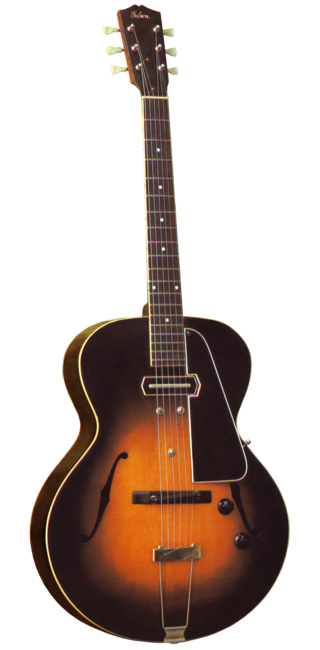
The Gibson ES-150 is a pioneering electric guitar produced by Gibson Guitar Corporation. Introduced in 1936, it is generally recognized as the world's first commercially successful Spanish-style electric guitar. The ES stands for Electric Spanish, and Gibson designated it "150" because they priced it at around $150. The particular sound of the instrument came from a combination of the specific bar-style pickup and its placement, and the guitar's overall construction.

A single-coil pickup is a type of magnetic transducer, or pickup, for the electric guitar and the electric bass. It electromagnetically converts the vibration of the strings to an electric signal. Single-coil pickups are one of the two most popular designs, along with dual-coil or "humbucking" pickups.

The Fender Jazzmaster is an electric guitar designed as a more expensive sibling of the Fender Stratocaster. First introduced at the 1958 NAMM Convention, it was initially marketed to jazz guitarists, but found favor among surf rock guitarists in the early 1960s. Its appearance is similar to the Fender Jaguar, though it is tonally and physically different in many technical ways, including pickup design, scale length and controls.
The Fender Jaguar is an electric guitar by Fender Musical Instruments characterized by an offset-waist body, a relatively unusual switching system with two separate circuits for lead and rhythm, and a short-scale 24" neck. Owing some roots to the Jazzmaster, it was introduced in 1962 as Fender's feature-laden top-of-the-line model, designed to lure players from Gibson. During its initial 13-year production run, the Jaguar did not sell as well as the less expensive Stratocaster and Telecaster, and achieved its most noticeable popularity in the surf music scene. After the Jaguar was taken out of production in 1975, vintage Jaguars became popular first with American punk rock players, and then more so during the alternative rock, shoegazing and indie rock movements of the 1980s and 1990s. Fender began making a version in Japan in the mid-1980s, and then introduced a USA-made reissue in 1999. Since then, Fender has made a variety of Jaguars in America, Mexico, Indonesia and China under both the Fender and Squier labels. Original vintage Jaguars sell for many times their original price.

The Fender Cyclone denotes a series of electric guitars made by Fender. Introduced in late 1997, the Cyclone body is similarly styled to the Mustang, but it is a quarter of an inch thicker than the body of a Mustang and is made of poplar, whereas contemporary Mustang reissues were made of basswood.
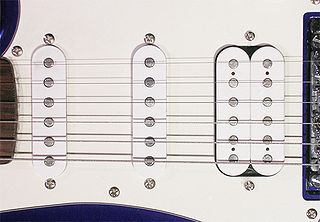
A pickup is an electronic device that converts energy from one form to another that captures or senses mechanical vibrations produced by musical instruments, particularly stringed instruments such as the electric guitar, and converts these to an electrical signal that is amplified using an instrument amplifier to produce musical sounds through a loudspeaker in a speaker enclosure. The signal from a pickup can also be recorded directly.
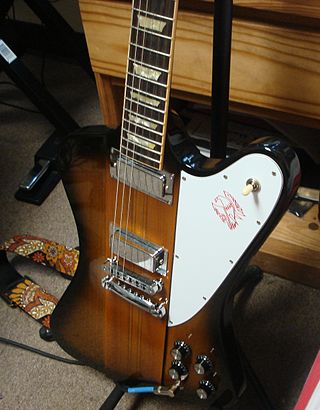
The Gibson Firebird is a solid-body electric guitar manufactured by Gibson beginning in 1963.

The Fender Telecaster Deluxe is a solid-body electric guitar originally produced from 1972 to 1981, and re-issued by Fender multiple times starting in 2004.
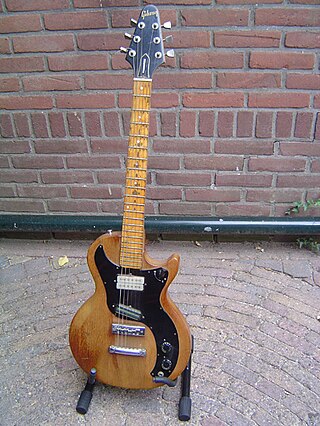
The Gibson Marauder was an electric guitar model produced by Gibson between 1975 and 1979. Designed to compete with guitars made by Fender, it had limited success and was discontinued after only 7,111 had been sold.

The P-90 is a single coil electric guitar pickup produced by Gibson Guitar Corporation since 1946, as well as other vendors. Compared to other single coil designs, such as the Fender single coil, the bobbin for a P-90 is wider but shorter. The Fender style single coil is wound in a taller bobbin, but the wires are closer to the individual poles. This makes the P-90 produce a somewhat warmer tone with less edge and brightness, As with other single-coil pickups, the P-90 is subject to AC hum unless some form of cancellation is used.

A P.A.F., or simply PAF, is an early model of the humbucker guitar pickup invented by Seth Lover in 1955, so named for the "Patent Applied For" decal placed on the baseplate of each pickup. Gibson used the PAF on guitars from late 1956 until late 1962, long after the patent was granted. They were replaced by the Patent Number pickup, essentially a refined version of the PAF. These were in turn replaced by "T-Top" humbuckers in 1967, and production ended in 1975. Though it was not the first humbucking pickup ever, it was the first to gain widespread use, as the PAF's hum-free signal, tonal clarity, and touch sensitivity when paired with overdriven amplifiers made the pickups popular with rock and blues guitarists. The PAF is an essential tonal characteristic of the now-famous 1957–1960 Gibson Les Paul Standard guitars, and pickups of this type have gained a large following.
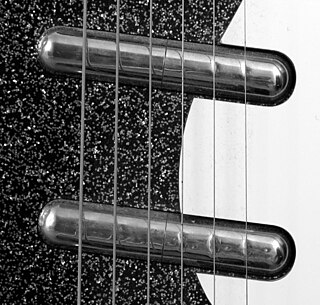
A lipstick guitar pickup is a form of single-coil magnetic guitar pickup, having its electronics totally encased in a chrome-plated metal tube.

Fender Telecaster Custom is a model of electric guitar made by Fender.
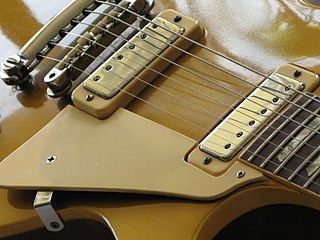
The mini-humbucker is a humbucking guitar pickup. It was originally created by the Epiphone company. The mini-humbucker resembles a Gibson PAF humbucker, but is narrower in size and senses a shorter length of string vibration. This produces clearer, brighter tones that are quite unlike typical Gibson sounds. It fits in between single-coils and full-sized humbuckers in the tonal spectrum. It is frequently used in jazz guitars, mounted under the fingerboard or on the pickguard.

The Gibson Nighthawk was a family of electric guitars manufactured by Gibson. Introduced in 1993, the Nighthawk represented a radical change from traditional Gibson designs. While its maple-capped mahogany body and set neck were reminiscent of the classic Gibson Les Paul, the Nighthawk incorporated a number of characteristics more commonly associated with Fender guitars. The Nighthawk was not a commercial success; production of all models was discontinued in 1998 after only five years.
The Fender Bullet was an electric guitar originally designed by John Page and manufactured and marketed by the Fender Musical Instruments Corporation. It was first introduced as a line of "student" guitars to replace the outgoing Mustang and Musicmaster models.

The Fender Noiseless series is a line of electric guitar pickups made by the Fender Musical Instruments Corporation designed to cancel 60 cycle (Hz) hum noise while retaining the characteristic sound of single coil pickups. Introduced in 1998, these pickups consist of a pair of single coils stacked one on top of the other, compacted so as to match the shape and width space as a traditional Fender single coil guitar pickup, while being only slightly taller. The upper coil is actually the sound source, while the lower coil is responsible for the mains hum attenuation. Alnico 5 magnetic bars span from one coil to the other, crossing a soft ferrous steel spacer plate that isolates them, without touching it. The spacer plate has mainly two functions: to isolate the lower coil from the vibrations of the string, making sure that the sound is picked up only from the upper one, and to increase the magnetic flux that passed through both coils, increasing the output of the pickup. This is to be contrasted with the original noise canceling pickup, the humbucker, which is a double-wide, horizontally adjacent pair of single coil pickups with opposing phase.

Guitar wiring refers to the electrical components, and interconnections thereof, inside an electric guitar. It most commonly consists of pickups, potentiometers to adjust volume and tone, a switch to select between different pickups, and the output socket. There may be additional controls for specific functions; the most common of these are described below.
The Fender Telecaster, colloquially known as the tele, is an electric guitar produced by Fender. Together with its sister model the Esquire, it was the world's first mass-produced, commercially successful solid-body electric guitar. Its simple yet effective design and revolutionary sound broke ground and set trends in electric guitar manufacturing and popular music. Many prominent rock musicians have been associated with the Telecaster for use in studio recording and live performances, most notably Bruce Springsteen, Prince, Luis Alberto Spinetta and Keith Richards.

















